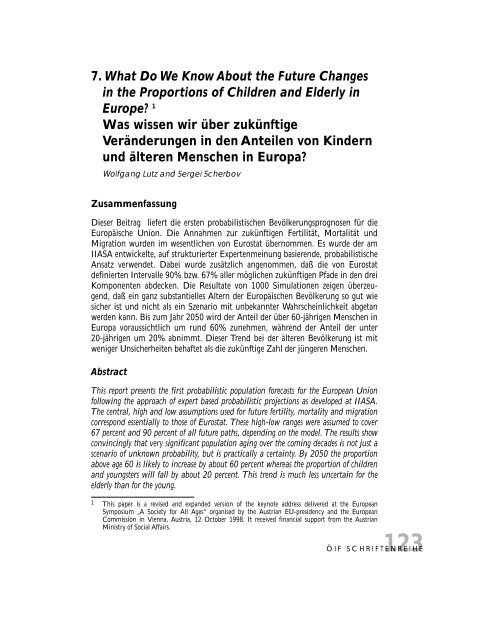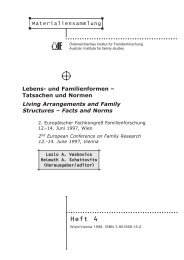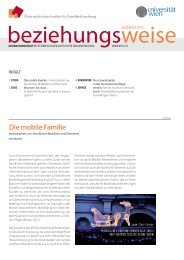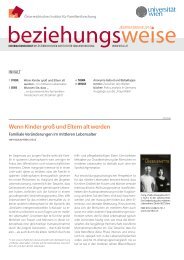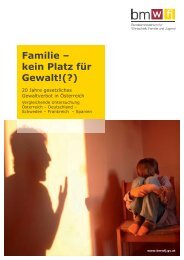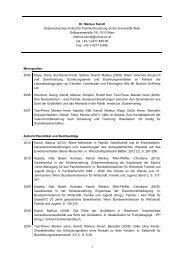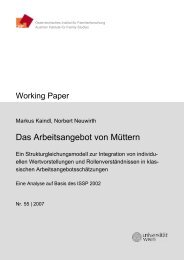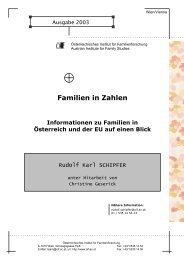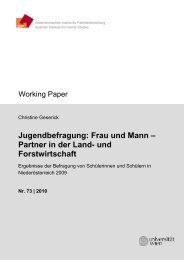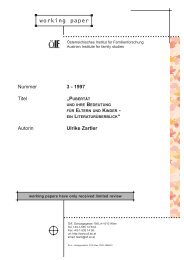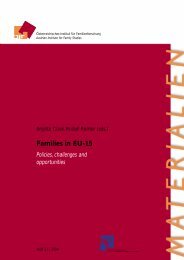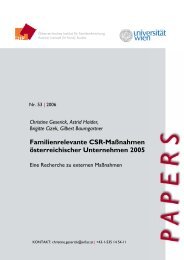Kompendium der Familienforschung in Ãsterreich, Schriftenreihe Nr. 7
Kompendium der Familienforschung in Ãsterreich, Schriftenreihe Nr. 7
Kompendium der Familienforschung in Ãsterreich, Schriftenreihe Nr. 7
Sie wollen auch ein ePaper? Erhöhen Sie die Reichweite Ihrer Titel.
YUMPU macht aus Druck-PDFs automatisch weboptimierte ePaper, die Google liebt.
7. What Do We Know About the Future Changes<br />
<strong>in</strong> the Proportions of Children and El<strong>der</strong>ly <strong>in</strong><br />
Europe? 1<br />
Was wissen wir über zukünftige<br />
Verän<strong>der</strong>ungen <strong>in</strong> den Anteilen von K<strong>in</strong><strong>der</strong>n<br />
und älteren Menschen <strong>in</strong> Europa?<br />
Wolfgang Lutz and Sergei Scherbov<br />
Zusammenfassung<br />
Dieser Beitrag liefert die ersten probabilistischen Bevölkerungsprognosen für die<br />
Europäische Union. Die Annahmen zur zukünftigen Fertilität, Mortalität und<br />
Migration wurden im wesentlichen von Eurostat übernommen. Es wurde <strong>der</strong> am<br />
IIASA entwickelte, auf strukturierter Expertenme<strong>in</strong>ung basierende, probabilistische<br />
Ansatz verwendet. Dabei wurde zusätzlich angenommen, daß die von Eurostat<br />
def<strong>in</strong>ierten Intervalle 90% bzw. 67% aller möglichen zukünftigen Pfade <strong>in</strong> den drei<br />
Komponenten abdecken. Die Resultate von 1000 Simulationen zeigen überzeugend,<br />
daß e<strong>in</strong> ganz substantielles Altern <strong>der</strong> Europäischen Bevölkerung so gut wie<br />
sicher ist und nicht als e<strong>in</strong> Szenario mit unbekannter Wahrsche<strong>in</strong>lichkeit abgetan<br />
werden kann. Bis zum Jahr 2050 wird <strong>der</strong> Anteil <strong>der</strong> über 60-jährigen Menschen <strong>in</strong><br />
Europa voraussichtlich um rund 60% zunehmen, während <strong>der</strong> Anteil <strong>der</strong> unter<br />
20-jährigen um 20% abnimmt. Dieser Trend bei <strong>der</strong> älteren Bevölkerung ist mit<br />
weniger Unsicherheiten behaftet als die zukünftige Zahl <strong>der</strong> jüngeren Menschen.<br />
Abstract<br />
This report presents the first probabilistic population forecasts for the European Union<br />
follow<strong>in</strong>g the approach of expert based probabilistic projections as developed at IIASA.<br />
The central, high and low assumptions used for future fertility, mortality and migration<br />
correspond essentially to those of Eurostat. These high-low ranges were assumed to cover<br />
67 percent and 90 percent of all future paths, depend<strong>in</strong>g on the model. The results show<br />
conv<strong>in</strong>c<strong>in</strong>gly that very significant population ag<strong>in</strong>g over the com<strong>in</strong>g decades is not just a<br />
scenario of unknown probability, but is practically a certa<strong>in</strong>ty. By 2050 the proportion<br />
above age 60 is likely to <strong>in</strong>crease by about 60 percent whereas the proportion of children<br />
and youngsters will fall by about 20 percent. This trend is much less uncerta<strong>in</strong> for the<br />
el<strong>der</strong>ly than for the young.<br />
1 This paper is a revised and expanded version of the keynote address delivered at the European<br />
Symposium „A Society for All Ages“ organised by the Austrian EU-presidency and the European<br />
Commission <strong>in</strong> Vienna, Austria, 12 October 1998. It received f<strong>in</strong>ancial support from the Austrian<br />
M<strong>in</strong>istry of Social Affairs.<br />
123<br />
ÖIF SCHRIFTENREIHE


